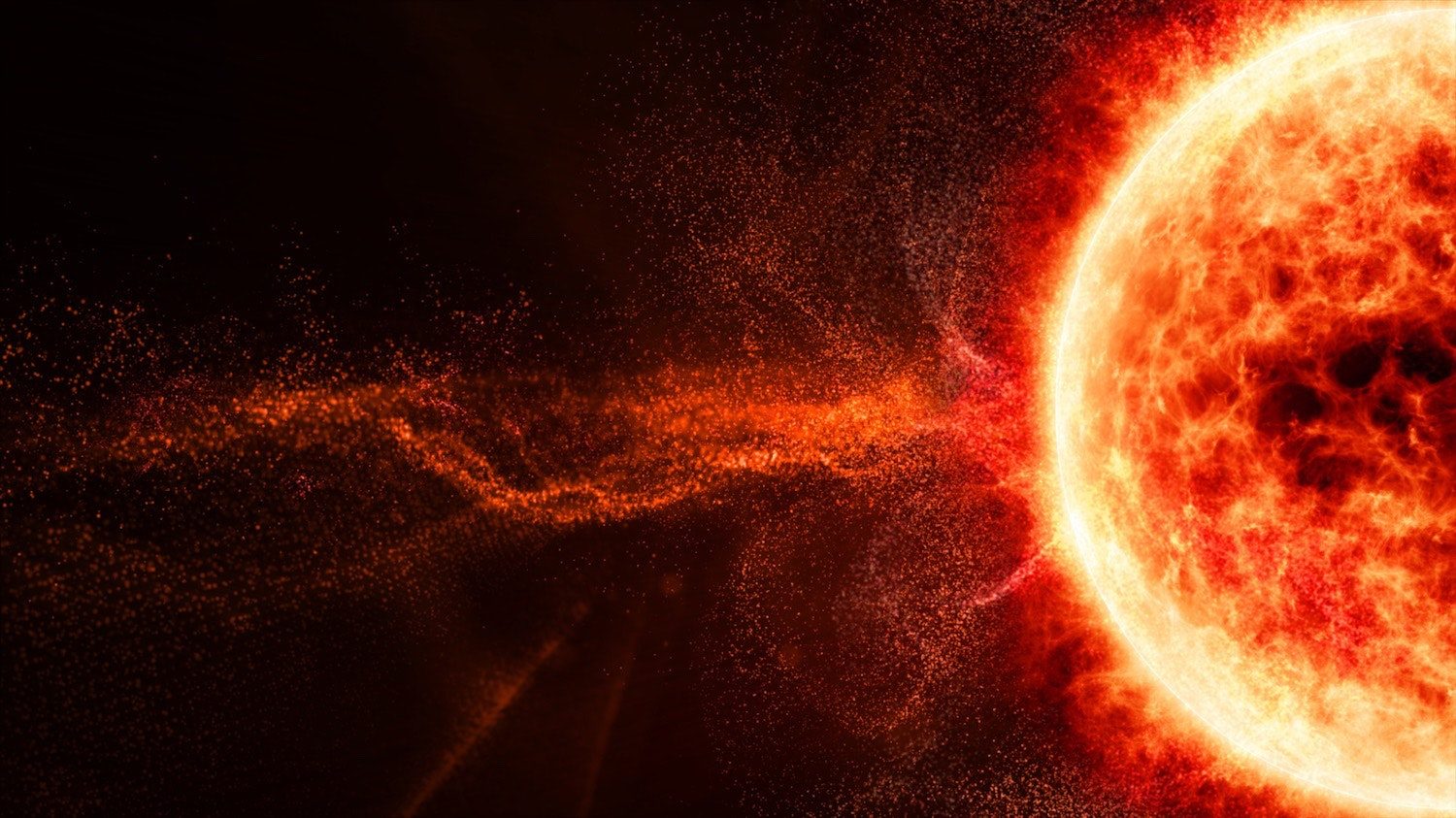
© LV4260/Getty ImagesAn artist's impression of a coronal mass ejection.
Astronomers using one of the most sensitive arrays of radio telescopes in the world
have caught a huge storm erupting on the sun and observed material flung from it at more than 3000 kilometres a second, a massive shockwave and phenomena known as herringbones.In the
journal Nature Astronomy, Diana Morosan from the University of Helsinki in Finland and her colleagues report detailed observations of the huge storm, a magnetic eruption known as a coronal mass ejection (CME).
Unlike the herringbones a biologist might find while dissecting, well, a herring, the team found a data-based version while dissecting the radio waves emitted during the violent event.
The shape of the fish skeleton emerged when they plotted the frequencies of radio waves as the CME evolved. The spine is a band of emission at a constant frequency, while the vertical offshoot "bones" on either side were sudden short bursts of radiation at a much wider range of frequencies.
Herringbones have been found in the sun's radio-wave entrails before, but this is the first time that such a sensitive array of radio telescopes has recorded them. The detailed data enabled Morosan and colleagues for the first time to pin down the origin of the radiation bursts.
To their surprise, the bones were being created in three different locations, on the sides of the CME.
"I was very excited when I first saw the results, I didn't know what to make of them," Morosan says.
As the CME erupted, the astronomers were already monitoring the sun, using 24 radio telescopes from the Low Frequency Array (LOFAR) distributed around an area of about 320 hectares near the village of Exloo in The Netherlands.
"We had seen this really complicated active region - really big ugly sunspots, that had already produced three X-class flares, so we thought we should point LOFAR at it and see if it produces any other eruptions," explains Morosan.
A last minute request to the LOFAR director was rewarded with an eight-hour slot on the following Sunday, during which the active region erupted again, emitting X-rays so intense that it was classified as an X-class flare, the most extreme category.
Flares are caused by turbulence in the plasma that makes up the sun. Plasma is gas that is so hot that the electrons begin to be stripped from the atoms, forming a mixture of charged particles. As it swirls around in the sun the charged particles create magnetic fields. When the turbulence rises the magnetic field lines can get contorted and unstable, a little like a tightly coiled and tangled spring.
Sometimes the tangled magnetic field suddenly rearranges itself in a violent event called magnetic reconnection, a bit like a coiled spring breaking and thus releasing a lot of trapped energy. It is this energy that powers the flare and propels the plasma out into space to form the CME.
"The CME is still connected to the solar atmosphere via the magnetic field, so it looks like a giant bubble expanding out," Morosan says.
The extreme energy in the CME - the second largest during the sun's most recent 11-year cycle - accelerated matter away from the sun's surface to over 3000 kilometres per second, or 1% of the speed of light.
Because it was so fast the CME formed a shockwave as it travelled through the heliosphere - the atmosphere around the sun. Similar to the sonic boom created by a supersonic aircraft, the shockwave accelerated electrons to extreme speeds and caused them to emit radio waves that Morosan and her colleagues recorded.
The exact frequency of the radio waves emitted by the electrons depends on the density of their environment. Close to the sun the photosphere density is higher, which creates higher frequency radio waves. The further the electrons are from the sun the lower the frequency of the radio emission.
So the shape of the herringbones as a plot of frequencies shows where the accelerated electrons are in the sun's atmosphere.
The spine represents a constant frequency emission originating from electrons trapped in the shockwave. These escape in bursts from the shock and get funneled along the magnetic field lines on the surface of the CME bubble.
Some bursts of electrons are funneled back towards the sun. These are the herringbone offshoots to higher frequency, while the ones that get funneled the other way, out into space, create offshoots to lower frequency.
The sensitivity of the array of radio telescopes allowed the team to clearly identify three sources of herringbone radiation, all of them on the flanks of the CME, not at the front of it, as had been proposed.
However, the success of the observation was cut short because the timeslot on the LOFAR array came to its end, while the CME was still in full swing.
"We don't know what happened after the flare peaked," Morosan notes. "So we were lucky, and unlucky!"
"...tangled magnetic field..." Fields do not get entangled, they interact, governed by charge flow direction.
"...magnetic reconnection..." this is also a non-existent phenomenon. Magnetic fields do not connect, or re-connect.
"As it swirls around in the sun the charged particles create magnetic fields." This is the only description that comes close to being correct. Coherent movement of electrical charges are always accompanied by a magnetic field. An abrupt cessation of charge flow is what produces a sudden collapse in the magnetic field, distributing the energy in a chaotic release.
Astronomers need to take magnetic theory from a decent electrical engineering department and put an end to this nonsense being pawned on the public as science.